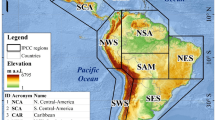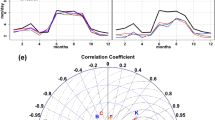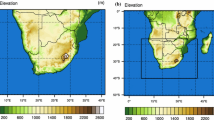Abstract
This study evaluated the performance of 25 earth system models (ESMs), statistically and dynamically downscaled to a high horizontal resolution (0.25° of latitude/longitude), in simulating extreme climate indices of temperature and precipitation for 1980–2005. Datasets analyzed include 21 statistically downscaled ESMs from the National Aeronautics and Space Administration (NASA) Earth Exchange Global Daily Downscaled Projections (NEX-GDDP) and dynamically downscaled Eta Regional Climate Model simulations driven by 4 ESMs generated by the Brazilian National Institute for Space Research (INPE). Downscaled outputs were evaluated against observational gridded datasets at 0.25° resolution over Brazil, quantifying the skill in simulating the observed spatial patterns and trends of climate extremes. Results show that the downscaled products are generally able to reproduce the observed climate indices, although most of them have poorest performance over the Amazon basin for annual and seasonal indices. We find larger discrepancies in the warm spell duration index for almost all downscaled ESMs. The overall ranking shows that three downscaled models (CNRM-CM5, CCSM4, and MRI-CGCM3) perform distinctively better than others. In general, the ensemble mean of the statistically downscaled models achieves better results than any individual models at the annual and seasonal scales. This work provides the largest and most comprehensive intercomparison of statistically and dynamically downscaled extreme climate indices over Brazil and provides a useful guide for researchers and developers to select the models or downscaling techniques that may be most suitable to their applications of interest over a given region.












Similar content being viewed by others
References
Aerenson T, Tebaldi C, Sanderson B, Lamarque J-F (2018) Changes in a suite of indicators of extreme temperature and precipitation under 1.5 and 2 degrees warming. Environ Res Lett 13:035009. https://doi.org/10.1088/1748-9326/aaafd6
Aguilar E, Peterson T, Obando P et al (2005) Changes in precipitation and temperature extremes in Central America and northern South America, 1961–2003. J Geophys Res 110:D23107. https://doi.org/10.1029/2005JD006119
Alexander L, Arblaster J (2017) Historical and projected trends in temperature and precipitation extremes in Australia in observations and CMIP5. Weather Climate Extrem 15:34–56. https://doi.org/10.1016/j.wace.2017.02.001
Alexander L, Zhang X, Peterson T et al (2006) Global observed changes in daily climate extremes of temperature and precipitation. J Geophys Res 111:1–22. https://doi.org/10.1029/2005jd006290
Ambrizzi T, Reboita M, da Rocha R, Llopart M (2019) The state-of-the-art and fundamental aspects of regional climate modeling in South America. Ann N Y Acad Sci 1436:98–120. https://doi.org/10.1111/nyas.13932
Ávila A, Justino F, Wilson A et al (2016) Recent precipitation trends, flash floods and landslides in southern Brazil. Environ Res Lett 11:114029. https://doi.org/10.1088/1748-9326/11/11/114029
Avila A, Guerrero F, Escobar Y, Justino F (2019) Recent precipitation trends and floods in the Colombian Andes. Water 11:379. https://doi.org/10.3390/w11020379
Avila-Diaz A, Benezoli V, Justino F et al (2020) Assessing current and future trends of climate extremes across Brazil based on Reanalyses and Earth System Model projections. Climate Dyn (in press)
Bezerra B, Silva L, Santos e Silva C, de Carvalho G (2019) Changes of precipitation extremes indices in São Francisco River Basin, Brazil from 1947 to 2012. Theor Appl Climatol 135:565–576. https://doi.org/10.1007/s00704-018-2396-6
Boulanger J, Martinez F, Segura E (2006) Projection of future climate change conditions using IPCC simulations, neural networks and Bayesian statistics. Part 1: temperature mean state and seasonal cycle in South America. Climate Dyn 27:233–259. https://doi.org/10.1007/s00382-006-0182-0
Boulanger J, Martinez F, Segura E (2007) Projection of future climate change conditions using IPCC simulations, neural networks and Bayesian statistics. Part 2: precipitation mean state and seasonal cycle in South America. Climate Dyn 27:233–259. https://doi.org/10.1007/s00382-006-0182-0
Bozkurt D, Rojas M, Boisier J et al (2019) Dynamical downscaling over the complex terrain of southwest South America: present climate conditions and added value analysis. Climate Dyn 53:6745–6767. https://doi.org/10.1007/s00382-019-04959-y
Brito S, Cunha A, Cunningham C et al (2018) Frequency, duration and severity of drought in the Semiarid Northeast Brazil region. Int J Climatol 38:517–529. https://doi.org/10.1002/joc.5225
Burger G, Murdock Q, Werner A et al (2011) Downscaling extremes—an intercomparison of multiple statistical methods for present climate. J Climate 25:4366–4388. https://doi.org/10.1175/JCLI-D-11-00408.1
Campozano L, Vázquez-Patiño A, Tenelanda D et al (2017) Evaluating extreme climate indices from CMIP3&5 global climate models and reanalysis data sets: a case study for present climate in the Andes of Ecuador. Int J Climatol 37:363–379. https://doi.org/10.1002/joc.5008
Carvalho J, Assad E, de Oliveira A, Pinto H (2014) Annual maximum daily rainfall trends in the midwest, southeast and southern Brazil in the last 71 years. Weather Climate Extrem 5:7–15. https://doi.org/10.1016/j.wace.2014.10.001
Cheng C, Knutson T (2008) On the verification and comparison of extreme rainfall indices from climate models. J Climate 21:1605–1621. https://doi.org/10.1175/2007JCLI1494.1
Chou S, Lyra A, Mourão C et al (2014a) Evaluation of the eta simulations nested in three global climate models. Am J Climate Change 03:438–454. https://doi.org/10.4236/ajcc.2014.35039
Chou S, Lyra A, Mourão C et al (2014b) Assessment of climate change over South America under RCP 4.5 and 8.5 downscaling scenarios. Am J Climate Change 03:512–527. https://doi.org/10.4236/ajcc.2014.35043
Coelho C, Cardoso D, Firpo M (2016a) Precipitation diagnostics of an exceptionally dry event in São Paulo, Brazil. Theor Appl Climatol 125:769–784. https://doi.org/10.1007/s00704-015-1540-9
Coelho C, de Oliveira C, Ambrizzi T et al (2016b) The 2014 southeast Brazil austral summer drought: regional scale mechanisms and teleconnections. Climate Dyn 46:3737–3752. https://doi.org/10.1007/s00382-015-2800-1
da Silva V, da Silva B, Albuquerque W et al (2013) Crop coefficient, water requirements, yield and water use efficiency of sugarcane growth in Brazil. Agric Water Manag 128:102–109. https://doi.org/10.1016/j.agwat.2013.06.007
Darela-Filho J, Lapola D, Torres R, Lemos M (2016) Socio-climatic hotspots in Brazil: how do changes driven by the new set of IPCC climatic projections affect their relevance for policy? Clim Change 136:413–425. https://doi.org/10.1007/s10584-016-1635-z
Debortoli N, Camarinha P, Marengo J, Rodrigues R (2017) An index of Brazil’s vulnerability to expected increases in natural flash flooding and landslide disasters in the context of climate change. Nat Hazards 86:557–582. https://doi.org/10.1007/s11069-016-2705-2
Dereczynski C, Silva W, Marengo J (2013) Detection and projections of climate change in Rio de Janeiro, Brazil. Am J Climate Change 02:25–33. https://doi.org/10.4236/ajcc.2013.21003
Donat M, Alexander L, Yang H et al (2013) Updated analyses of temperature and precipitation extreme indices since the beginning of the twentieth century: the HadEX2 dataset. J Geophys Res Atmos 118:2098–2118. https://doi.org/10.1002/jgrd.50150
Dosio A, Jones R, Jack C et al (2019) What can we know about future precipitation in Africa? Robustness, significance and added value of projections from a large ensemble of regional climate models. Climate Dyn. https://doi.org/10.1007/s00382-019-04900-3
Espinoza J, Marengo J, Ronchail J et al (2014) The extreme 2014 flood in south-western Amazon basin: the role of tropical-subtropical South Atlantic SST gradient. Environ Res Lett 9:1–9. https://doi.org/10.1088/1748-9326/9/12/124007
Giorgi F (2006) Climate change hot-spots. Geophys Res Lett 33:1–4. https://doi.org/10.1029/2006GL025734
Gupta H, Sorooshian S, Yapo P (1999) Status of automatic calibration for hydrologic models: comparison with multilevel expert calibration. J Hydrol Eng 4:135–143. https://doi.org/10.1061/(ASCE)1084-0699(1999)4:2(135)
Jiang Z, Li W, Xu J, Li L (2015) Extreme precipitation indices over China in CMIP5 models. Part I: model evaluation. J Climate 28:8603–8619. https://doi.org/10.1175/JCLI-D-15-0099.1
Jones PW (1999) First- and second-order conservative remapping schemes for grids in spherical coordinates. Mon Weather Rev 127:2204–2210. https://doi.org/10.1175/1520-0493(1999)127%3c2204:FASOCR%3e2.0.CO;2
Kendall MG (1975) Rank correlation methods, 4th edn. Charles Griffin, London
Knutti R, Furrer R, Tebaldi C et al (2010) Challenges in combining projections from multiple climate models. J Climate 23:2739–2758. https://doi.org/10.1175/2009JCLI3361.1
Kusunoki S, Arakawa O (2015) Are CMIP5 models better than CMIP3 models in simulating precipitation over East Asia? J Climate 28:5601–5621. https://doi.org/10.1175/JCLI-D-14-00585.1
Liao X, Xu W, Zhang J et al (2019) Global exposure to rainstorms and the contribution rates of climate change and population change. Sci Total Environ 663:644–653. https://doi.org/10.1016/j.scitotenv.2019.01.290
Lin L, Wang Z, Xu Y et al (2018) Larger sensitivity of precipitation extremes to aerosol than greenhouse gas forcing in CMIP5 models. J Geophys Res Atmos 123:8062–8073. https://doi.org/10.1029/2018JD028821
Loaiza W, Kayano M, Andreoli R et al (2020) Streamflow intensification driven by the Atlantic multidecadal oscillation (AMO) in the Atrato River Basin, Northwestern Colombia. Water 12:216. https://doi.org/10.3390/w12010216
Lyra A, Tavares P, Chou S et al (2018) Climate change projections over three metropolitan regions in Southeast Brazil using the non-hydrostatic Eta regional climate model at 5-km resolution. Theor Appl Climatol 132:663–682. https://doi.org/10.1007/s00704-017-2067-z
Mann HB (1945) Nonparametric tests against trend. Econometrica 13:245–259. https://doi.org/10.2307/1907187
Marengo J, Camargo C (2008) Surface air temperature trends in Southern Brazil for 1960–2002. Int J Climatol 28:893–904. https://doi.org/10.1002/joc.1584
Marengo J, Jones B, Alvesa L et al (2009) Future change of temperature and precipitation extremes in south america as derived from the PRECIS regional climate modeling system. Int J Climatol 29:2241–2255. https://doi.org/10.1002/joc.1863
Marengo J, Ambrizzi T, da Rocha R et al (2010a) Future change of climate in South America in the late twenty-first century: intercomparison of scenarios from three regional climate models. Climate Dyn 35:1089–1113. https://doi.org/10.1007/s00382-009-0721-6
Marengo J, Rusticucci M, Penalba O, Renom M (2010b) An intercomparison of observed and simulated extreme rainfall and temperature events during the last half of the twentieth century: part 2: historical trends. Clim Change 98:509–529. https://doi.org/10.1007/s10584-009-9743-7
Marengo J, Chou S, Kay G et al (2012) Development of regional future climate change scenarios in South America using the Eta CPTEC/HadCM3 climate change projections: climatology and regional analyses for the Amazon, São Francisco and the Paraná River basins. Climate Dyn 38:1829–1848. https://doi.org/10.1007/s00382-011-1155-5
Marengo J, Torres R, Alves L (2017) Drought in Northeast Brazil—past, present, and future. Theor Appl Climatol 129:1189–1200. https://doi.org/10.1007/s00704-016-1840-8
Marengo J, Alves L, Alvala R et al (2018) Climatic characteristics of the 2010–2016 drought in the semiarid Northeast Brazil region. An Acad Bras Cienc 90:1973–1985. https://doi.org/10.1590/0001-3765201720170206
MCTI (2016) Third National Communication of Brazil to the United Nations framework convention on climate change. Ministry of Science Technology and Innovation, Brasilia
Missirian A, Schlenker W (2017) Asylum applications respond to temperature fluctuations. Science 358:1610–1614. https://doi.org/10.1126/science.aao0432
Moriasi D, Arnold J, Van Liew M et al (2007) Model evaluation guidelines for systematic quantification of accuracy in watershed simulations. Trans ASABE 50:885–900. https://doi.org/10.13031/2013.23153
Murara P, Acquaotta F, Garzena D, Fratianni S (2018) Daily precipitation extremes and their variations in the Itajaí River Basin, Brazil. Meteorol Atmos Phys 131:1145–1156. https://doi.org/10.1007/s00703-018-0627-0
Mysiak J, Torresan S, Bosello F et al (2018) Climate risk index for Italy. Phil Trans R Soc A. https://doi.org/10.1098/rsta.2017.0305
Nguyen P, Thorstensen A, Sorooshian S et al (2017) Evaluation of CMIP5 model precipitation using PERSIANN-CDR. J Hydrometeorol 18:2313–2330. https://doi.org/10.1175/JHM-D-16-0201.1
Oliveira P, Silva C, Lima K (2014) Linear trend of occurrence and intensity of heavy rainfall events on Northeast Brazil. Atmos Sci Lett 15:172–177. https://doi.org/10.1002/asl2.484
Oliveira P, Silva C, Lima K (2017) Climatology and trend analysis of extreme precipitation in subregions of Northeast Brazil. Theor Appl Climatol 130:77–90. https://doi.org/10.1007/s00704-016-1865-z
Raghavan S, Hur J, Liong S (2018) Evaluations of NASA NEX-GDDP data over Southeast Asia: present and future climates. Clim Change 148:503–518. https://doi.org/10.1007/s10584-018-2213-3
Rao V, Franchito S, Santo C, Gan M (2016) An update on the rainfall characteristics of Brazil: seasonal variations and trends in 1979–2011. Int J Climatol 36:291–302. https://doi.org/10.1002/joc.4345
Ray D, Gerber J, Macdonald G, West P (2015) Climate variation explains a third of global crop yield variability. Nat Commun 6:1–9. https://doi.org/10.1038/ncomms6989
Rosso F, Boiaski N, Ferraz S et al (2015) Trends and decadal variability in air temperature over Southern Brazil. Am J Environ Eng 5:85–95. https://doi.org/10.5923/s.ajee.201501.12
Rusticucci M, Marengo J, Penalba O, Renom M (2010) An intercomparison of model-simulated in extreme rainfall and temperature events during the last half of the twentieth century. Part 1: mean values and variability. Clim Change 98:493–508. https://doi.org/10.1007/s10584-009-9742-8
Santos M, Fragoso M, Santos J (2017) Regionalization and susceptibility assessment to daily precipitation extremes in mainland Portugal. Appl Geogr 86:128–138. https://doi.org/10.1016/j.apgeog.2017.06.020
Seinfeld J, Bretherton C, Carslaw K et al (2016) Improving our fundamental understanding of the role of aerosol−cloud interactions in the climate system. Proc Natl Acad Sci 113:5781–5790. https://doi.org/10.1073/pnas.1514043113
Sen PK (1968) Estimates of the regression coefficient based on Kendall’s tau. J Am Stat Assoc 63:1379–1389. https://doi.org/10.2307/2285891
Sheffield J, Goteti G, Wood E et al (2006) Development of a 50-year high-resolution global dataset of meteorological forcings for land surface modeling. J Climate 19:3088–3111. https://doi.org/10.1175/JCLI3790.1
Sillmann J, Kharin V, Zhang X et al (2013a) Climate extremes indices in the CMIP5 multimodel ensemble: part 1. Model evaluation in the present climate. J Geophys Res Atmos 118:1716–1733. https://doi.org/10.1002/jgrd.50203
Sillmann J, Kharin V, Zwiers W et al (2013b) Climate extremes indices in the CMIP5 multimodel ensemble: part 2. Future climate projections. J Geophys Res Atmos 118:2473–2493
Skansi M, Brunet M, Sigró J et al (2013) Warming and wetting signals emerging from analysis of changes in climate extreme indices over South America. Glob Planet Change 100:295–307. https://doi.org/10.1016/j.gloplacha.2012.11.004
Tang J, Niu X, Wang S et al (2016) Statistical downscaling and dynamical downscaling of regional climate in China: present climate evaluations and future climate projections. J Geophys Res Atmos 121:2110–2129. https://doi.org/10.1002/2015JD023977
Thrasher B, Maurer E, McKellar C, Duffy P (2012) Technical note: bias correcting climate model simulated daily temperature extremes with quantile mapping. Hydrol Earth Syst Sci 16:3309–3314. https://doi.org/10.5194/hess-16-3309-2012
Tomasella J, Pinho P, Borma L et al (2013) The droughts of 1997 and 2005 in Amazonia: floodplain hydrology and its potential ecological and human impacts. Clim Change 116:723–746. https://doi.org/10.1007/s10584-012-0508-3
Torres R, Marengo J (2013) Uncertainty assessments of climate change projections over South America. Theor Appl Climatol 112:253–272. https://doi.org/10.1007/s00704-012-0718-7
Torres R, Marengo J (2014) Climate change hotspots over South America: from CMIP3 to CMIP5 multi-model datasets. Theor Appl Climatol 117:579–587. https://doi.org/10.1007/s00704-013-1030-x
Valverde M, Marengo J (2014) Extreme rainfall indices in the hydrographic basins of Brazil. Open J Mod Hydrol 4:10–26. https://doi.org/10.4236/ojmh.2014.41002
Vincent L, Peterson T, Barros V et al (2005) Observed trends in indices of daily temperature extremes in South America 1960–2000. J Climate 18:5011–5023. https://doi.org/10.1175/JCLI3589.1
Wilby R, Dawson C (2013) The statistical downscaling model: insights from one decade of application. Int J Climatol 33:1707–1719. https://doi.org/10.1002/joc.3544
Willmott C, Robeson S, Matsuura K (2012) A refined index of model performance. Int J Climatol 32:2088–2094. https://doi.org/10.1002/joc.2419
Willmott C, Robeson S, Matsuura K, Ficklin D (2015) Assessment of three dimensionless measures of model performance. Environ Model Softw 73:167–174. https://doi.org/10.1016/j.envsoft.2015.08.012
Xavier A, King W, Scanlon B (2015) Daily gridded meteorological variables in Brazil (1980–2013). Int J Climatol 36:2644–2659. https://doi.org/10.1002/joc.4518
Xavier A, King C, Bridget S (2017) An update of Xavier, King and Scanlon (2016) daily precipitation gridded data set for the Brazil. Conference proceedings, pp 562–569. https://proceedings.science/sbsr/papers/an-update-of-xavier--king-and-scanlon--2016--daily-precipitation-gridded-data-set-for-the-brazil
Xu K, Wu C, Hu B (2019) Projected changes of temperature extremes over nine major basins in China based on the CMIP5 multimodel ensembles. Stoch Environ Res Risk Assess 33:321–339. https://doi.org/10.1007/s00477-018-1569-2
Yin L, Fu R, Shevliakova E, Dickinson R (2013) How well can CMIP5 simulate precipitation and its controlling processes over tropical South America? Climate Dyn 41:3127–3143. https://doi.org/10.1007/s00382-012-1582-y
You Q, Jiang Z, Wang D et al (2017) Simulation of temperature extremes in the Tibetan Plateau from CMIP5 models and comparison with gridded observations. Climate Dyn 51:355–369. https://doi.org/10.1007/s00382-017-3928-y
Yue S, Pilon P, Cavadias G (2002) Power of the Mann–Kendall and Spearman’s rho tests for detecting monotonic trends in hydrological series. J Hydrol 259:254–271. https://doi.org/10.1016/S0022-1694(01)00594-7
Zhang X, Yang F, Canada E (2004) RClimDex (1.0) User Guide. Climate Research Branch Environment Canada, Downsview, Ontario, Canada, pp 1–22
Zhang X, Alexander L, Hegerl G et al (2011) Indices for monitoring changes in extremes based on daily temperature and precipitation data. Wiley Interdiscip Rev Climate Change 2:851–870. https://doi.org/10.1002/wcc.147
Zhang Y, You Q, Chen C et al (2018) Evaluation of downscaled CMIP5 coupled with VIC model for flash drought simulation in a humid Subtropical Basin, China. J Climate 31:1075–1090. https://doi.org/10.1175/JCLI-D-17-0378.1
Acknowledgements
The authors would like to thank the Universidade Federal de Viçosa. This work was supported by Minas Gerais Research Foundation (FAPEMIG) and to the Coordination for the Improvement of Higher Education Personnel (CAPES). The authors thank to the Byrd Polar and Climate Research Center. The authors are grateful to the climate simulations used from National Institute for Space Research (INPE), and we thank NEX-GDDP dataset, prepared by the Climate Analytics Group and NASA Ames Research Center using the NASA Earth Exchange, and distributed by the NASA Center for Climate Simulation (NCCS). The authors further thank Alexandre Xavier, Carey King, and Bridget Scanlon that provided a gridded observational dataset used in this work.
Author information
Authors and Affiliations
Corresponding author
Additional information
Publisher's Note
Springer Nature remains neutral with regard to jurisdictional claims in published maps and institutional affiliations.
Electronic supplementary material
Below is the link to the electronic supplementary material.
Rights and permissions
About this article
Cite this article
Avila-Diaz, A., Abrahão, G., Justino, F. et al. Extreme climate indices in Brazil: evaluation of downscaled earth system models at high horizontal resolution. Clim Dyn 54, 5065–5088 (2020). https://doi.org/10.1007/s00382-020-05272-9
Received:
Accepted:
Published:
Issue Date:
DOI: https://doi.org/10.1007/s00382-020-05272-9




